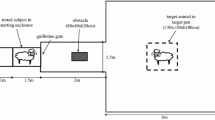Abstract
Brain lateralization enables preferential processing of certain stimuli and more effective utilization of these stimuli in either the left or the right cerebral hemisphere. Horses show both motor and sensory lateralization patterns. Our aim was to determine whether a lateralized response could be detected in foals during the naturally side-biased behaviour, suckling. The foals’ preferred suckling side could be the effect of either visual or motor lateralization. In the case of a visual lateralized response, foals are expected to suck more often from the mother’s right side, so potential danger can be detected by the better adapted right hemisphere (i.e. left eye). Motor lateralization can be identified when a foal will suck predominantly from one side, either left or right. We found no population trend in the preferred suckling side, but we detected significant differences amongst individual foals. One-third (35.4 %) of 79 foals showed a strong, either right or left side preference which increased with age. The mothers did not influence the foals’ suckling side preferences either by side-biased rejection or termination of suckling. According to our findings, a general pattern of sucking with the left eye open for better danger detection and recognition is unlikely in foals up to 7 months old. Foals of this age are probably young or fully focused on suckling and rely on their mothers’ vigilance. Individual side preferences amongst foals are suggested to be based on motor lateralization.


Similar content being viewed by others
References
Altmann J (1974) Observational study of behavior: sampling methods. Behaviour 49:227–267
Austin NP, Rogers LJ (2007) Asymmetry of flight and escape turning responses in horses. Laterality 12:464–474
Austin NP, Rogers LJ (2012) Limb preferences and lateralization of aggression, reactivity and vigilance in feral horses, Equus caballus. Anim Behav 83:239–247
Bartošová J, Komárková M, Dubcová J, Bartoš L, Pluháček J (2011) Concurrent lactation and pregnancy: pregnant domestic horse mares do not increase mother-offspring conflict during intensive lactation. PLoS One 6(8):e22068. doi:10.1371/journal.pone.0022068
Bisazza A, Cantalupo C, Robins A, Rogers L, Vallortigara G (1996) Right-pawedness in toads. Nature 379:408
Bonati B, Csermely D, López P, Martín J (2010) Lateralization in the escape behaviour of the common wall lizard (Podarcis muralis). Behav Brain Res 207:1–6
Cameron EZ, Stafford KJ, Linklater WL, Veltman CJ (1999) Suckling behaviour does not measure milk intake in horses, Equus caballus. Anim Behav 57:673–678
Cummings JF, De Lahunta A (1969) An experimental study of the retinal projections in the horse and sheep. Ann NY Acad Sci 167:293–318
Dharmaretnam M, Rogers LJ (2005) Hemispheric specialization and dual processing in strongly versus weakly lateralized chicks. Behav Brain Res 162:62–70
Farmer K, Krueger K, Byrne RW (2010) Visual laterality in the domestic horse (Equus caballus) interacting with humans. Anim Cogn 13:229–238
Güven M, Elalmis DD, Binokay S, Tan U (2003) Population-level right-paw preference in rats assessed by a new computerized food-reaching test. Int J Neurosci 113:1675–1689
Komárková M, Bartošová J, Dubcová J (2011) Effect of mares’ dominance rank on suckling behaviour in the loose housed domestic horses. Appl Anim Behav Sci 133:54–59
Larose C, Rogers LJ, Ricard-Yris MA, Hausberger M (2006) Laterality of horses associated with emotionality in novel situations. Laterality 11:355–367
MacNeilage P, Rogers LJ, Vallortigara G (2009) Origins of the left and right brain. Sci Am 301:60–67
McGreevy PD, Rogers LJ (2005) Motor and sensory laterality in thoroughbred horses. Appl Anim Behav Sci 92:337–352
McGreevy PD, Thomson PC (2006) Differences in motor laterality between breeds of performance horse. Appl Anim Behav Sci 99:183–190
Murphy J, Sutherland A, Arkins S (2005) Idiosyncratic motor laterality in the horse. Appl Anim Behav Sci 91:297–310
Pluháček J, Bartoš L, Bartošová J (2010a) Mother–offspring conflict in captive plains zebra (Equus burchellii): suckling bout duration. Appl Anim Behav Sci 122:127–132
Pluháček J, Bartošová J, Bartoš L (2010b) Suckling behavior in captive plains zebra (Equus burchellii): sex differences in foal behaviour. J Anim Sci 88(1):131–136
Robins A, Phillips C (2010) Lateralized visual processing in domestic cattle herds responding to novel and familiar stimuli. Laterality 15:514–534
Robins R, Rogers LJ (2006) Complementary and lateralized forms of processing in Bufo marinus for novel and familiar prey. Neurobiol Learn Mem 86:214–227
Rogers LJ (2010) Relevance of brain and behavioural lateralization to animal welfare. Appl Anim Behav Sci 127:1–11
Rogers LJ, Andrew RJ (2002) Comparative vertebrate lateralization. Cambridge University Press, Cambridge
Rogers LJ, Workman L (1993) Footedness in birds. Anim Behav 45:409–411
Vallortigara J (2006) Cerebral lateralization: a common theme in the organization of the vertebrate brain. Cortex 42:5–7
Vallortigara G, Rogers LJ, Bisazza A, Lippolis G, Robins A (1998) Complementary right and left hemifield use for predatory and agonistic behavior. NeuroReport 9:3341–3344
Van Heel MCV, Kroekenstoel AM, van Dierendonck MC, van Weeren PR, Back W (2006) Uneven feet in a foal may develop as a consequence of lateral grazing behaviour induced by conformational traits. Equine Vet J 38:646–651
Acknowledgments
We would like to thank Lenka Gotthardová and Jan Höck, the former and current directors, as well as to other staff, mainly Illona Křížová and Eva Kozlová, of the National Stud Kladruby nad Labem, for their support and assistance. We are grateful to Jitka Komárková, Marta Komárková and Jana Dubcová for excellent field assistance and to Professor Stephen E. G. Lea, Katrina Franken and Jan Kokoška for improving English of the manuscript. We highly appreciate helpful comments on the manuscript by Jan Pluháček, Luděk Bartoš and two anonymous referees. The project was supported by the Ministry of Agriculture of the Czech Republic (project Nos. QH92265 and MZe0002701404).
Author information
Authors and Affiliations
Corresponding author
Rights and permissions
About this article
Cite this article
Komárková, M., Bartošová, J. Lateralized suckling in domestic horses (Equus caballus). Anim Cogn 16, 343–349 (2013). https://doi.org/10.1007/s10071-012-0575-x
Received:
Revised:
Accepted:
Published:
Issue Date:
DOI: https://doi.org/10.1007/s10071-012-0575-x




